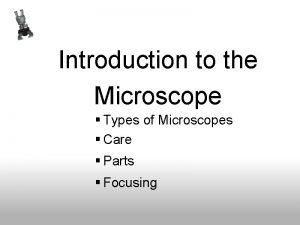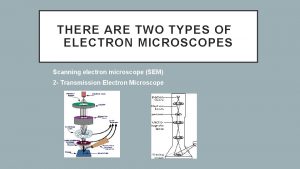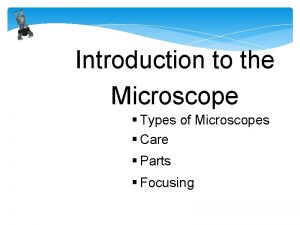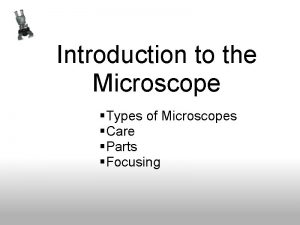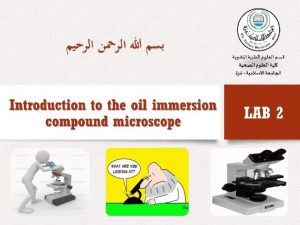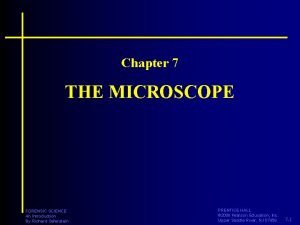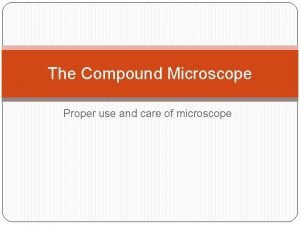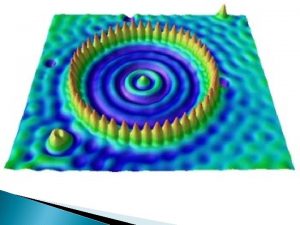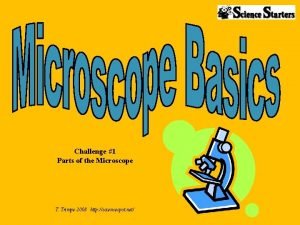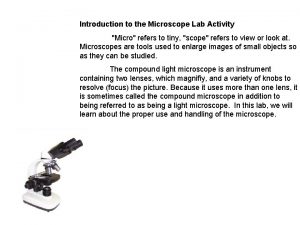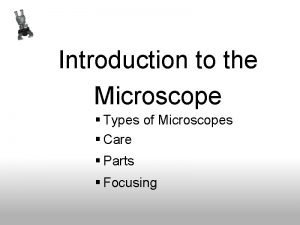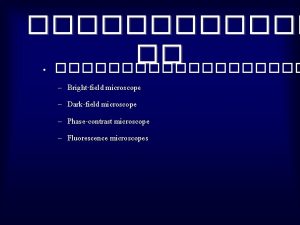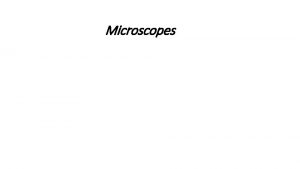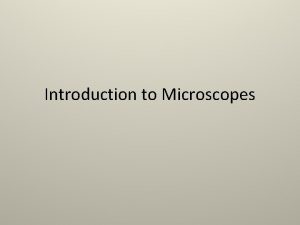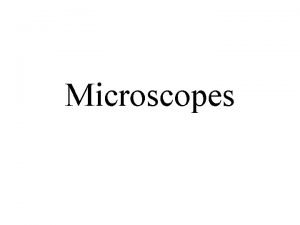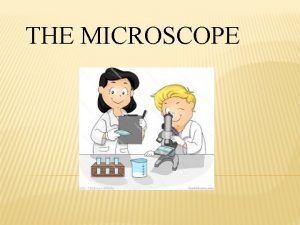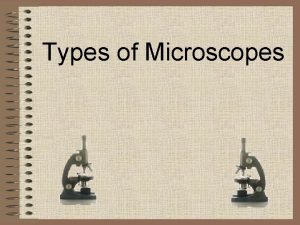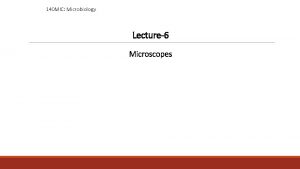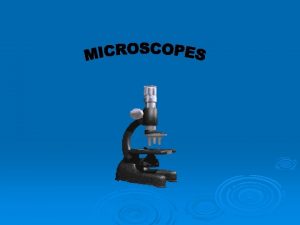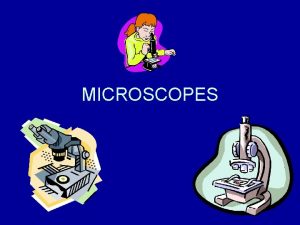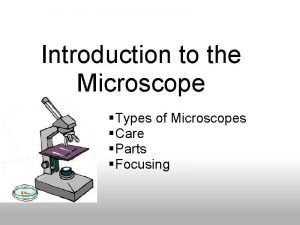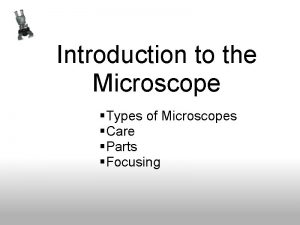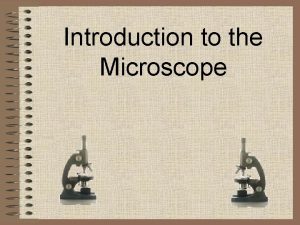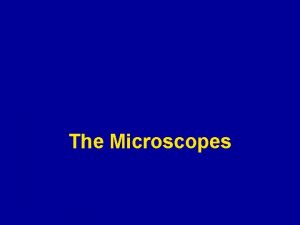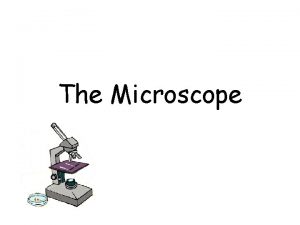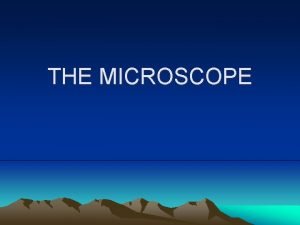Introduction to the Microscope Types of Microscopes Care























- Slides: 23

Introduction to the Microscope § Types of Microscopes § Care § Parts § Focusing

Types of Microscopes Light Microscope - the models found in most schools, use compound lenses to magnify objects. The lenses bend or refract light to make the object beneath them appear closer. Common magnifications: 40 x, 100 x, 400 x (*multiply ocular x objective) *Oil Immersion lenses can improve quality of focus and magnification (1000 x)

Stereoscope This microscope allows for binocular (two eyes) viewing of larger specimens. Usually magnifies 2 20 x Can be used for thicker specimens Creates a 3 D view of specimen

Scanning Electron Microscope - allows scientists to view a universe too small to be seen with a light microscope. SEMs do not use light waves; they use electrons (negatively charged electrical particles) to magnify objects up to two million times. SEM creates a 3 D view of specimen, but cannot view living specimens (process kills them)

Transmission Electron Microscope - also uses electrons, but instead of scanning the surface (as with SEM's) electrons are passed through very thin specimens. TEM = "thin"

TEM of a cell, notice you see the inside of the cell and not the surface.

Microscope Resources Virtual Microscopes (Phase Contrast, Fluorescence, TEM, STM) at http: //nobelprize. org/educational/physics/microscopes/1. html Nanoworld Image Gallery Microworld Images

Types of Illumination in Microscopes How light passes through a specimen changes the view of the specimen, making some parts more distinct.

The Light Microscope Guidelines for Use • Always carry with 2 hands • Only use lens paper for cleaning • Do not force knobs • Always store covered • Keep objects clear of desk and cords

Eyepiece Body Tube Revolving Nosepiece Objective Lens Stage Clips Diaphragm Light Arm Stage Coarse Focus Fine Focus Base

Magnification Your microscope has 3 magnifications: Scanning, Low and High. Each objective will have the magnification. In addition to this, the ocular lens (eyepiece) has a magnification. The total magnification is the ocular x objective. Some of our scopes have a 4 th objective (oil immersion). Magnification is 100 x.

General Procedures 1. Make sure all backpacks and other items are out of the aisles and off the tops of desks. 2. Plug in your microscope (do not have cord near sinks!). 3. Store with cord LOOSELY wrapped around microscope and the scanning objective clicked into place. Make sure it is covered when it is stored on the shelf. 4. Carry by the base and arm with both hands.

Focusing Specimens 1. Always start with the scanning objective. Odds are, you will be able to see something on this setting. Use the Coarse Knob to focus, image may be small at this magnification, but you won't be able to find it on the higher powers without this first step. These are PARFOCAL microscopes. Do NOT use the coarse objective knob on any other objectives…only use on SCAN! Once the scope is in “rough” focus on scan, it will be in rough focus on

2. Once you've focused on Scanning, switch to Low Power. Use the Fine Knob to refocus. Again, if you haven't focused on this level, you will not be able to move to the next level. 3. Now switch to High Power. (If you have a thick slide, or a slide without a cover, do NOT use the high power objective). ONLY use the Fine Adjustment Knob to focus specimens. NEVER USE COARSE ADJUSTMENT ON HIGHER POWERS! Recap 1. Scanning --> use coarse knob 2. Low power --> use fine knob 3. High power --> use fine knob DO NOT SKIP STEPS!!!!

• Your slide MUST be focused on low power before attempting this step • Click the nosepiece to the longest objective • Do NOT use the Coarse Focusing Knob, this could crack the slide or the lens • Use the Fine Focus Knob to bring the slide in view

Drawing Specimens 1. Use pencil - you can erase and shade areas 2. All drawings should include clear and proper labels (and be large enough to view details). Drawings should be labeled with the specimen name and magnification. 3. Labels should be written on the outside of the circle. The circle indicates the viewing field as seen through the eyepiece, specimens should be drawn to scale - ie. . if your specimen takes up the whole viewing field, make sure your drawing reflects that. 4. You MUST use a RULER to draw your lines! NO FREE HANDED LINES, or there will be a deduction! Write words at the END of the line!. The title and magnification must be written.

Making a Wet Mount 1. Gather a thin slice/peice of whatever your specimen is. If your specimen is too thick, then the coverslip will wobble on top of the sample like a see-saw, and you will not be able to view it under High Power. 2. Place ONE drop of water directly over the specimen. If you put too much water, then the coverslip will float on top of the water, making it hard to draw the specimen, because they might actually float away. (Plus too much water is messy) 3. Place the cover slip at a 45 degree angle (approximately) with one edge touching the water drop and then gently let go. Performed correctly the coverslip will perfectly fall over the specimen. Do not drop vertically, set one edge down and let the other side drop.

How to Stain a Slide 1. Place one drop of stain (iodine, methylene blue. . there are many kinds) on the edge of the coverslip. 2. Place the flat edge of a piece of paper towel on the opposite side of the coverlip. The paper towel will draw the water out from under the coverslip, and the cohesion of water will draw the stain under the slide. 3. As soon as the stain has covered the area containing the specimen, you are finished. The stain does not need to be under the entire coverslip. If the stain does not cover as needed, get a new piece of paper towel and add more stain until it does. 4. Be sure to wipe off the excess stain with a paper towel.

Cleanup 1. Store microscopes with the scanning objective in place. 2. Wrap cords and cover microscopes. *Double check to make sure you didn't leave a slide 3. Wash slides in the sinks and dry them, either on a paper towel or, if dry, placing them back in the slide boxes to be used later. 4. *Be careful not to drop cover slips in the sink, they can clog drain. 5. Place microscopes in their designated location (probably a cabinet)

Troubleshooting Occasionally you may have trouble with working your microscope. Here are some common problems and solutions. 1. Image is too dark! Adjust the diaphragm, make sure your light is on. Make sure the reset switch near the plug has not turned off. You may need to push the switch again to close the circuit. 2. There's a spot in my viewing field, even when I move the slide the spot stays in the same place! Your lens is dirty. Use lens paper, and only lens paper to carefully clean the objective and ocular lens. The ocular lens can be removed to clean the inside. The spot is probably a spec of dust. 3. I can't see anything under high power! Remember the steps, if you can't focus under scanning and then low power, you won't be able to focus anything under high power. Start at scanning and walk through the steps again. 4. Only half of my viewing field is lit, it looks like there's a half-moon in there! You probably don't have your objective fully clicked into place. 5. The bulb doesn’t work. Is it plugged in? Turned on (switch)? Lever (if applicable) adjusted? Breaker switch checked?

Practice Labeling the Parts

Quiz Over the Microscope 1. When focusing a specimen, you should always start with the __________ objective. 2. When using the high power objective, only the ______ knob should be used. 3. The type of microscope used in most science classes is the _________ microscope 4. Stains can be drawn under the slide (and over a specimen) by using a ___________ 5. What part of the microscope can adjust the amount of light that hits the slide? _______________

6. You should carry the microscope by the ____ and the _____. 7. The objectives are attached to what part of the microscope (it can be rotated to click the lenses into place): ________________ 8. You should always store you microscope with the ________ objective in place. 9. A microscope has an ocular objective of 10 x and a high power objective of 50 x. What is this microscope's total magnification? ______ 10. SEM is an abbreviation for ____________ _________
 When focusing a specimen, you should always start with the
When focusing a specimen, you should always start with the Types of electron microscope
Types of electron microscope Types of microscopes
Types of microscopes Types of microscopes
Types of microscopes T.trimpe 2006 http sciencespot.net
T.trimpe 2006 http sciencespot.net The purpose of a microscope
The purpose of a microscope Forensic science microscopes
Forensic science microscopes Which organelle breaks down food
Which organelle breaks down food Uses of a light microscope
Uses of a light microscope Electron microscopes main idea
Electron microscopes main idea Levels of care primary secondary tertiary
Levels of care primary secondary tertiary Difference between light microscope and electron microscope
Difference between light microscope and electron microscope Microscope mania compound light microscope
Microscope mania compound light microscope Microscope discovered by
Microscope discovered by Introduction to the microscope lab
Introduction to the microscope lab Microscope introduction
Microscope introduction Hình ảnh bộ gõ cơ thể búng tay
Hình ảnh bộ gõ cơ thể búng tay Frameset trong html5
Frameset trong html5 Bổ thể
Bổ thể Tỉ lệ cơ thể trẻ em
Tỉ lệ cơ thể trẻ em Chó sói
Chó sói Tư thế worm breton
Tư thế worm breton Alleluia hat len nguoi oi
Alleluia hat len nguoi oi Môn thể thao bắt đầu bằng từ đua
Môn thể thao bắt đầu bằng từ đua
